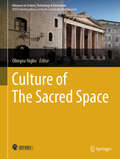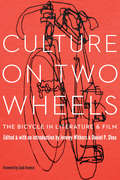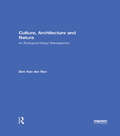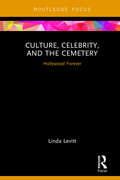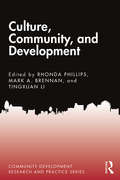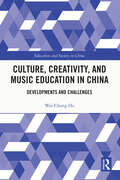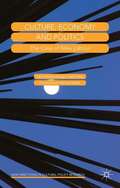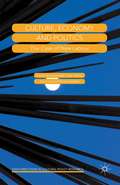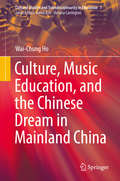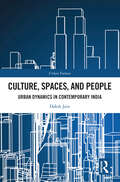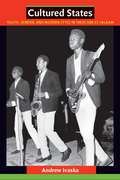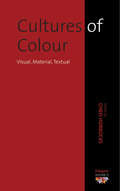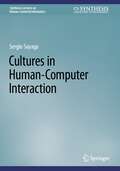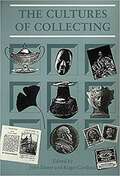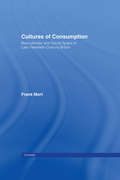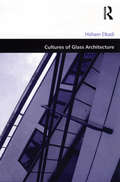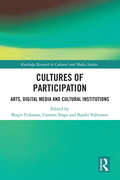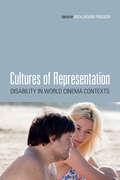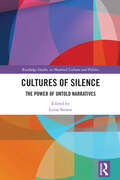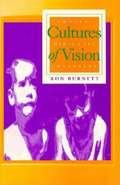- Table View
- List View
Culture of The Sacred Space (Advances in Science, Technology & Innovation)
by Olimpia NiglioThis book highlights the relationship between sacred architecture and tourism, specifically focusing on the role of interior design strategies. It explores how the interior design of sacred spaces can influence the tourist experience and shape their perception of these places. The book touches upon elements such as spatial organization, symbolism, material selection, lighting, and acoustics, all of which contribute to creating a meaningful and immersive environment for visitors. It explores the architectural design, ideological motivations, and the historical context surrounding the palace's construction. The book also addresses the eventual abandonment of the project and its transformation of their uses, reflecting on the complexities of realizing utopian visions in architecture. It examines how the sanctuary's architectural design and spatial arrangement interact with the surrounding landscape, including elements such as topography, vegetation, and water features. Moreover, it focuses on the interior design and explores the symbolism, spatial organization, artistic elements, and spiritual experiences associated with the dome interiors of these structures. The book showcases the historical context, cultural influences, and the evolution of design principles that shaped these remarkable spaces. Also, this book investigates the transition of visionary architectural drawings from the realm of professional architects. Furthermore, it explores how architectural drawings serve as a medium for expressing imaginative and utopian ideas, and how this transition occurs in the context of architectural education.
Culture on Two Wheels: The Bicycle in Literature and Film
by Zack Furness Jeremy Withers Daniel P. SheaBicycles have more cultural identities than many realize, functioning not only as literal vehicles in a text but also as “vehicles” for that text’s themes, ideas, and critiques. In the late nineteenth century the bicycle was seen as a way for the wealthy urban elite to reconnect with nature and for women to gain a measure of personal freedom, while during World War II it became a utilitarian tool of the French Resistance and in 1970s China stood for wealth and modernization. Lately it has functioned variously as the favored ideological steed of environmentalists, a means of community bonding and aesthetic self-expression in hip hop, and the ride of choice for bike messenger–idolizing urban hipsters. Culture on Two Wheels analyzes the shifting cultural significance of the bicycle by examining its appearances in literary, musical, and cinematic works spanning three continents and more than 125 years of history. Bringing together essays by a variety of cyclists and scholars with myriad angles of approach, this collection highlights the bicycle’s flexibility as a signifier and analyzes the appearance of bicycles in canonical and well-known texts such as Samuel Beckett’s modernist novel Molloy, the Oscar-winning film Breaking Away, and various Stephen King novels and stories, as well as in lesser-known but equally significant texts, such as the celebrated Russian director Andrei Tarkovsky’s film Sacrifice and Elizabeth Robins Pennell’s nineteenth-century travelogue A Canterbury Pilgrimage, the latter of which traces the route of Chaucer’s pilgrims via bicycle. Listen to an interview with the author.
Culture+Typography
by Nikki VillagomezInspire your type designs with the side-by-side travel photo comparisons in Culture+Typograhpy by Nikki Villagomez. Each image features examples of typography in culture and is accompanied by cultural and historical commentary. Explore how design choices can be informed by the language of the cultural surroundings, and learn more about type selection, color usage and more with this book.
Culture+Typography: How Culture Affects Typography
by Nikki VillagomezInspire your type designs with the side-by-side travel photo comparisons in Culture+Typograhpy by Nikki Villagomez. Each image features examples of typography in culture and is accompanied by cultural and historical commentary. Explore how design choices can be informed by the language of the cultural surroundings, and learn more about type selection, color usage and more with this book.
Culture, Architecture and Nature: An Ecological Design Retrospective
by Sim Van der RynGathering his most compelling essays and addresses from the last fifty years in one accessible volume, this book looks at the pioneering ideas that underpin Sim Van der Ryn’s ecological design philosophy. It offers a unique decade-by-decade retrospective of the key issues in environmental design, beginning with the most recent years and looking back to the 1960s. With an introductory chapter and further recommended reading for each decade, this book is key reading for any architect or designer practising today, and students will find a wealth of knowledge with which to support their studies. The author’s beautiful illustrations, painted in a corresponding timescale to the chapters, offer further insight into the way he understands the challenges of humanity’s stewardship of our planet.
Culture, Celebrity, and the Cemetery: Hollywood Forever (Heritage, Tourism, and Community)
by Linda LevittMonuments and memorials commemorating the dead and past events around the world have recently gained importance, not least because we are living in an era in which many are driven to record and archive the events of their lives. Cemeteries, in particular, are increasingly viewed as places associated with popular culture and cultural memory, with many now being considered as heritage tourism sites. Culture, Celebrity, and the Cemetery analyses the famous Hollywood Forever Cemetery in Los Angeles, USA, examining how the cemetery presents itself as an attraction, whilst also safeguarding and promoting cultural heritage. Focusing on an analysis of the articulation and performance of commemoration, Levitt examines how the cemetery leverages its rich resources to draw visitors and the diverse ways in which visitors interact with the cemetery, considering the influence of celebrity culture, fandoms, and cinema culture. Combining ethnographic research with cultural analysis, the book situates Hollywood Forever in the context of cemetery development in the United States and argues that touristic visits to cemeteries more generally have become similar to visits to more traditional memorials. Providing more than just a critical analysis of this fascinating cemetery as a landscape of famous death, Levitt coherently weaves the theme of cultural memory and meaning-making throughout every chapter. Offering the first book-length study of the cultural impact of Hollywood Forever in particular, and the cemetery as public heritage space in general, Culture, Celebrity, and the Cemetery will be of interest to scholars and students of heritage studies and tourism around the world.
Culture, Community, and Development (Community Development Research and Practice Series)
by Rhonda Phillips Mark A. BrennanCulture is a living thing. In social settings, it is often used to represent entire ways of life, including rules, values, and expected behavior. Varying from nation to nation, neighborhood to neighborhood and beyond, even in the smallest localities, culture is a motivating factor in the creation of social identity and serves as a basis for creating cohesion and solidarity. This book explores the intersection of culture and community as a basis for locally and regionally based development by focusing on three core bodies of literature: theory, research, and practice. The first section, theory, uncovers some of the more relevant historical arguments, as well as more contemporary examinations. Continuing, the research section sheds light on some of the key concepts, variables, and relationships present in the limited study of culture in community development. Finally, the practice section brings together research and theory into applied examples from on the ground efforts. During a time where the interest to retain the uniqueness of local life, traditions, and culture is significantly increasing in community-based development, the authors offer a global exploration of the impacts of culturally based development with comparative analysis in countries such as Korea, Ireland, and the United States. A must-read for community development planners, policymakers, students, and researchers.
Culture, Creativity, and Music Education in China: Developments and Challenges (Education and Society in China)
by Wai-Chung HoHo's book explores music education in China, and how creativity, education reforms, and social transformation can be enabled through music. The essential elements of music discussed include perception and creativity, sources and stimulation, and the integration of musical creativity in diverse cultures and participation. It focuses on three Chinese cities; Changsha and Hong Kong Special Administrative Region of China, which have creative industries, and Shijiazhuang, which has cultural industries. Readers will gain insights into the introduction of creativity into the Chinese education system through music, particularly during the pandemic. The author analyses official documents, selected music textbooks adopted by schools, questionnaire surveys, and in-depth interviews with both students and teachers. These interviews reveal the underbelly of the dilemmas of introducing creativity into schools through music education. The volume will be of interest to those keen to increase creativity in teaching through music, and researchers in the fields of creativity and music education. It will also interest students undertaking Chinese, teacher education, or music.
Culture, Economy and Politics: The Case Of New Labour (New Directions In Cultural Policy Research Ser.)
by David Lee David Hesmondhalgh Kate Oakley Melissa NisbettThis book focuses on cultural policy in the UK between 1997 and 2010 under the Labour party (or 'New Labour', as it was temporarily rebranded). It is based on interviews with major figures and examines a range of policy areas including the arts, creative industries, copyright, film policy, heritage, urban regeneration and regional policy.
Culture, Economy and Politics: The Case of New Labour (New Directions in Cultural Policy Research)
by David Lee David Hesmondhalgh Kate Oakley Melissa NisbettThis book focuses on cultural policy in the UK between 1997 and 2010 under the Labour party (or 'New Labour', as it was temporarily rebranded). It is based on interviews with major figures and examines a range of policy areas including the arts, creative industries, copyright, film policy, heritage, urban regeneration and regional policy.
Culture, History, and the Reception of Tennessee Williams in China (Chinese Literature and Culture in the World)
by Shouhua QiThis book is the first comprehensive study of the reception of Tennessee Williams in China, from rejection and/or misgivings to cautious curiosity and to full-throated acceptance, in the context of profound changes in China’s socioeconomic and cultural life and mores since the end of the Cultural Revolution. It fills a conspicuous gap in scholarship in the reception of one of the greatest American playwrights and joins book-length studies of Chinese reception of Shakespeare, Ibsen, O’Neill, Brecht, and other important Western playwrights whose works have been eagerly embraced and appropriated and have had catalytic impact on modern Chinese cultural life.
Culture, Innovation and the Economy
by James E. Doyle Biljana MickovThis is a handbook for the cultural entrepreneur, offering some of the best examples on practice, franchises, research, innovation and business opportunities in the cultural sector. The key theme is the contribution and possibilities of the cultural economy as a business, with a strong supporting subtext on innovative practice. The book illustrates the theme by providing multiple practice-based and empirical examples from an international panel of experts. Each contribution provides an accessible and easily accessed bank of knowledge on which existing practice can be grown and new projects undertaken. It provides an eclectic mix of possibilities that reinforce and underscore the full innovative and complex potential of the cultural economy. Topics include a review of the global and regional economic benefits of the cultural economy, evidence-based analysis of the culture industries, and an outline of the top ten cultural opportunities for business. This collection transcends the space between theory and practice to combine culture and innovation and understand their importance to a wider economy. This is essential reading for researchers and practitioners interested in entrepreneurship, non-profit management, art and visual culture, and public finance.
Culture, Music Education, and the Chinese Dream in Mainland China (Cultural Studies and Transdisciplinarity in Education #7)
by Wai-Chung HoThis book focuses on the rapidly changing sociology of music as manifested in Chinese society and Chinese education. It examines how social changes and cultural politics affect how music is currently being used in connection with the Chinese dream. While there is a growing trend toward incorporating the Chinese dream into school education and higher education, there has been no scholarly discussion to date. The combination of cultural politics, transformed authority relations, and officially approved songs can provide us with an understanding of the official content on the Chinese dream that is conveyed in today's Chinese society, and how these factors have influenced the renewal of values-based education and practices in school music education in China.
Culture, Spaces, and People: Urban Dynamics in Contemporary India (Urban Futures)
by Daksh JainThis volume discusses the nuances of cultural phenomena in the transforming urban landscape of Indian cities. It focuses on the role of globalization, transitioning economic patterns, National Urban policies in changing their urban landscape. The volume argues how culture is an important determinant of the emergent urban patterns. It decodes and determines the human centered inter-linkages such as social, cultural, economic, and political and their reactions in the transformations in urban morphology to understand the spatial perspective and visualization of new emerging cultural phenomena. The book reflects on the contemporary global forces and currently operational national urban policies that have enforced new dynamics of consumption, lifestyles, and institutions. Further, it also examines the ways in which these forces come together to create new hybrid cultures which manifest in spatial practices. With detailed case studies of different cities, this book will be of interest to students, teachers, and researchers of urban planning, cultural studies, urban sociology, urban geography, history, urban design, urban conservation, and policy studies. It will also be useful for professionals working in the field of smart cities in India and abroad, planning authorities, urban scientists, cultural tourists, artists, local cultural enthusiasts, and those interested in studying the urban conditions of Indian cities.
Cultured States: Youth, Gender, and Modern Style in 1960s Dar Es Salaam
by Andrew IvaskaCultured States is a vivid account of the intersections of postcolonial state power, the cultural politics of youth and gender, and global visions of modern style in Dar es Salaam, Tanzania, during the 1960s and early 1970s. Andrew Ivaska describes a cosmopolitan East African capital rocked by debates over youth culture, national cultural policy, the rumored sexual escapades of the postcolonial elite, the content of university education, leftist activism, and the reform of colonial-era marriage laws. If young Tanzanians saw themselves as full-fledged participants in modern global culture, their understandings of the modern conflicted with that of a state launching "decency campaigns" banning cultural forms such as soul music, miniskirts, wigs, and bell-bottoms. Promoted by the political elite as a radical break from the colonial order, these campaigns nonetheless contained strong echoes of colonial assumptions about culture, tradition, and African engagements with the modern city. Exploring the ambivalence over the modern at the heart of these contests, Ivaska uses them as lenses through which to analyze struggles around gender relations and sexual politics, youth and masculinity, and the competition for material resources in a Dar es Salaam in rapid flux. Cultured States is a major contribution to understandings of urban cultural politics; national political culture; social struggles around gender, generation, and wealth; and the transnational dimensions of postcolonial histories too often conceived within national frames.
Cultures Of Colour
by Chris HorrocksColour permeates contemporary visual and material culture and affects our senses beyond the superficial encounter by infiltrating our perceptions and memories and becoming deeply rooted in thought processes that categorise and divide along culturally constructed lines. Colour exists as a cultural as well as psycho-physical phenomenon and acquires a multitude of meanings within differing historical and cultural contexts. The contributors examine how colour becomes imbued with specific symbolic and material meanings that tint our constructions of race, gender, ideal bodies, the relationship of the self to others and of the self to technology and the built environment. By highlighting the relationship of colour across media and material culture, this volume reveals the complex interplay of cultural connotations, discursive practices and socio-psychological dynamics of colour in an international context.
Cultures in Human-Computer Interaction (Synthesis Lectures on Human-Centered Informatics)
by Sergio SayagoThis book provides an interdisciplinary synthesis of the topic of culture in the context of Human-Computer Interaction (HCI) and a structured overview of a large body of HCI research on (and with) culture. The book presents a short and guided overview of the concept of culture. It offers some background on the origin and development of the term culture. It also outlines some of its key traits and ingredients and summarizes three main perspectives of culture across disciplines. The book argues that culture matters considerably in HCI and discusses a number of reasons for and against its relevance. Arguments against include a lack of a universal or common definition of the term culture and globalization. Arguments in favor touch upon important aspects of HCI, including a diversely growing user base, the need to provide designers with enough support to design across cultures, and the inseparable relationship between culture and technology. The issues explored in this book can be classified into three, non-mutually exclusive, categories: theoretical, practical, and controversial. The book outlines the main conceptual perspectives of culture within HCI, including Geert Hofstede’s cultural dimensions theory, Edward T. Hall’s cross-cultural theory of communication, and Richard Nisbett’s cultural cognitive systems of thought as well as examining the ways in which culture has been operationalized in HCI research and the main functions of culture in this area. It closes with a discussion of some open issues intended to spark debate and future research. The literature this book draws upon covers a wide range of research disciplines, including Anthropology, Sociology, Cultural Studies, Robotics, Disability Studies, Cultural and Cross-Cultural Psychology, Usability, and Design. This book aspires to provide a useful overview of culture for HCI scholars at all levels.
Cultures of Collecting (Critical Views)
by J. ElsnerThis book traces the psychology, history and theory of the compulsion to collect, focusing not just on the normative collections of the Western canon, but also on collections that reflect a fascination with the "Other" and the marginal – the ephemeral, exotic, or just plain curious. There are essays on the Neoclassical architect Sir John Soane, Sigmund Freud and Kurt Schwitters, one of the masters of collage. Others examine imperialist encounters with remote cultures – the consquitadors in America in the sixteenth century, and the British in the Pacific in the eighteenth – and the more recent collectors of popular culture, be they of Swatch watches, Elvis Presley memorabilia or of packaging and advertising. With essays by Jean Baudrillard, Thomas DaCosta Kaufmann, Nicholas Thomas, Mieke Bal, John Forrester, John Windsor, Naomi Schor, Susan Stewart, Anthony Alan Shelton, John Elsner, Roger Cardinal and an interview with Robert Opie.
Cultures of Consumption (Comedia Ser.)
by Frank MortFirst Published in 1996. Routledge is an imprint of Taylor & Francis, an informa company.
Cultures of Glass Architecture (Design And The Built Environment Ser.)
by Hisham ElkadiWhen designing, architects are responding to and creating a relationship between identity, culture and architectural style. This book discusses whether the extent of the use of glass facades has increased, or indeed enhanced, the creation of meaningful place-making, thereby creating a cultural identity of 'place'. Looking at the development of perceptions of glass facades in different cultures, it shows how modernist 'glass' buildings are perceived as an expression of technical achievement, as symbols of global economic success and as setting a neutral platform for multi-cultural societies - all of which are difficult for urban developers and policy makers to resist in our era of globalization. Drawing on a number of modern and heritage design projects from Europe, the USA, the Middle East and South East Asia, the book reviews efforts of some regional towns and local places to move up the economic ladder by adopting a more 'global' aesthetic.
Cultures of Participation: Arts, Digital Media and Cultural Institutions (Routledge Research in Cultural and Media Studies)
by Carsten Stage Birgit Eriksson Bjarki ValtyssonThis book examines cultural participation from three different, but interrelated perspectives: participatory art and aesthetics; participatory digital media, and participatory cultural policies and institutions. Focusing on how ideals and practices relating to cultural participation express and (re)produce different "cultures of participation", an interdisciplinary team of authors demonstrate how the areas of arts, digital media, and cultural policy and institutions are shaped by different but interrelated contextual backgrounds. Chapters offer a variety of perspectives and strategies for empirically identifying "cultures of participation" and their current transformations and tensions in various regional and national settings. This book will be of interest to academics and cultural leaders in the areas of museum studies, media and communications, arts, arts education, cultural studies, curatorial studies and digital studies. It will also be relevant for cultural workers, artists and policy makers interested in the participatory agenda in art, digital media and cultural institutions.
Cultures of Representation: Disability in World Cinema Contexts
by Benjamin FraserCultures of Representation is the first book to explore the cinematic portrayal of disability in films from across the globe. Contributors explore classic and recent works from Belgium, France, Germany, India, Italy, Iran, Japan, Korea, Mexico, Netherlands, Russia, Senegal, and Spain, along with a pair of globally resonant Anglophone films. Anchored by David T. Mitchell and Sharon L. Snyder's coauthored essay on global disability-film festivals, the volume's content spans from 1950 to today, addressing socially disabling forces rendered visible in the representation of physical, developmental, cognitive, and psychiatric disabilities. Essays emphasize well-known global figures, directors, and industries - from Temple Grandin to Pedro Almodóvar, from Akira Kurosawa to Bollywood - while also shining a light on films from less frequently studied cultural locations such as those portrayed in the Iranian and Korean New Waves. Whether covering postwar Italy, postcolonial Senegal, or twenty-first century Russia, the essays in this volume will appeal to scholars, undergraduates, and general readers alike.
Cultures of Representation: Disability in World Cinema Contexts (Toronto Iberic Ser.)
by Benjamin FraserCultures of Representation is the first book to explore the cinematic portrayal of disability in films from across the globe. Contributors explore classic and recent works from Belgium, France, Germany, India, Italy, Iran, Japan, Korea, Mexico, Netherlands, Russia, Senegal, and Spain, along with a pair of globally resonant Anglophone films. Anchored by David T. Mitchell and Sharon L. Snyder's coauthored essay on global disability-film festivals, the volume's content spans from 1950 to today, addressing socially disabling forces rendered visible in the representation of physical, developmental, cognitive, and psychiatric disabilities. Essays emphasize well-known global figures, directors, and industries – from Temple Grandin to Pedro Almodóvar, from Akira Kurosawa to Bollywood – while also shining a light on films from less frequently studied cultural locations such as those portrayed in the Iranian and Korean New Waves. Whether covering postwar Italy, postcolonial Senegal, or twenty-first century Russia, the essays in this volume will appeal to scholars, undergraduates, and general readers alike.
Cultures of Silence: The Power of Untold Narratives (Routledge Studies in Material Culture and Politics)
by Luísa SantosThis book investigates the notion of silence as both an oppressing instrument and a powerful tool of resistance under the lenses and practices of cultural production. Taking a transdisciplinary and transcultural approach to the study of creative and cultural practices, the chapters ask how cultural production is dealing with surges of oppressive regimes, censorship, and fake news, and which cultural processes are implied in silencing as well in giving voice to, in erasing, and in producing small and grand narratives. The book reaches beyond dominant instrumental views of contemporary cultural practice to understand culture not only as an expedient to conduct social policy, but also as a diagnostic tool and a vernacular space of giving voice to the many small narratives that make the world we live in. Offering an introduction to an underrepresented area of cultural studies, this truly interdisciplinary volume will be of interest to scholars of cultural studies, cultural history, media studies, politics, visual studies, communication studies, history, and literature.
Cultures of Vision: Images, Media, and the Imaginary
by Ron Burnett"This is a very strong, thought-provoking [volume]... "--George MarcusAs home photographs shift from the print format to digital technology and as video moves from the television screen to multimedia, it is crucial to develop new strategies of interpreting and analyzing these images. Visit the author's World Wide Web site: (2/19/03: Link is no longer active)http://www.facl.mcgill.ca/burnett/englishhome.html
